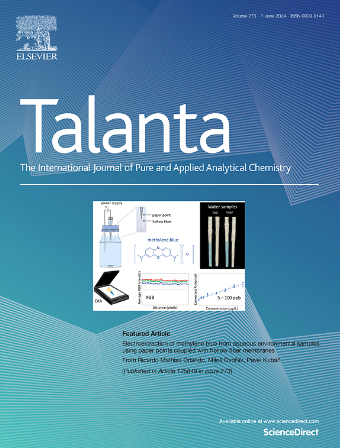Surface engineered gold nanodendrites decorated flexible carbon fiber-based electrochemical sensor platform for sensitive detection of L-Cysteine in serum and urine samples
IF 5.6
1区 化学
Q1 CHEMISTRY, ANALYTICAL
引用次数: 0
Abstract
In this work, highly dispersed gold nanodendrites (Au NDs) decorated flexible carbon fiber electrode (Au NDs@FCF electrode) were fabricated by facile, green, and one-step electrochemical deposition protocol and utilized for the direct electrochemical determination of L-Cysteine (L-Cys). The prepared Au NDs@FCF electrodes were characterized by SEM, HR-TEM, XRD, XPS, CV, and EIS towards the dimensions, surface morphological traits, crystalline nature, chemical composition, and electrochemical catalytic oxidation towards L-Cys and electrochemical active surface area (ECASA) of the Au NDs. The developed Au NDs@FCF electrode demonstrates an enzyme mimics electrocatalytic efficiency towards the oxidation of L-Cys at the operating potential of 0.82 V (vs Ag/AgCl) with a lower experimental detection limit of 0.16 nM, higher sensitivity of ∼50.2 μA μM−1 cm−2, and a wide concentration ranges from 100 to 3000 nM with a correlation coefficient of R2 = 0.996. In addition, the developed Au NDs@FCF electrode has exhibited excellent selectivity with various anti-interferences such as glucose, dopamine, uric acid, Na+, Mg2+, Ca2+, high reproducibility, and repeatability with RSD of 2.3 %. The Au NDs@FCF electrode demonstrates outstanding electrocatalytic oxidation and a rapid sensing response time of ∼3 s. The current Au NDs@FCF electrode achieving the successful detection of L-Cys in practical human serum and urine samples highlights its potential application in biomedical diagnostics. This advancement indicates that the sensor can effectively operate in real-world conditions, offering a valuable tool for medical professionals to monitor L-Cys levels in patients accurately.

求助全文
约1分钟内获得全文
求助全文
来源期刊

Talanta
化学-分析化学
CiteScore
12.30
自引率
4.90%
发文量
861
审稿时长
29 days
期刊介绍:
Talanta provides a forum for the publication of original research papers, short communications, and critical reviews in all branches of pure and applied analytical chemistry. Papers are evaluated based on established guidelines, including the fundamental nature of the study, scientific novelty, substantial improvement or advantage over existing technology or methods, and demonstrated analytical applicability. Original research papers on fundamental studies, and on novel sensor and instrumentation developments, are encouraged. Novel or improved applications in areas such as clinical and biological chemistry, environmental analysis, geochemistry, materials science and engineering, and analytical platforms for omics development are welcome.
Analytical performance of methods should be determined, including interference and matrix effects, and methods should be validated by comparison with a standard method, or analysis of a certified reference material. Simple spiking recoveries may not be sufficient. The developed method should especially comprise information on selectivity, sensitivity, detection limits, accuracy, and reliability. However, applying official validation or robustness studies to a routine method or technique does not necessarily constitute novelty. Proper statistical treatment of the data should be provided. Relevant literature should be cited, including related publications by the authors, and authors should discuss how their proposed methodology compares with previously reported methods.
 求助内容:
求助内容: 应助结果提醒方式:
应助结果提醒方式:


